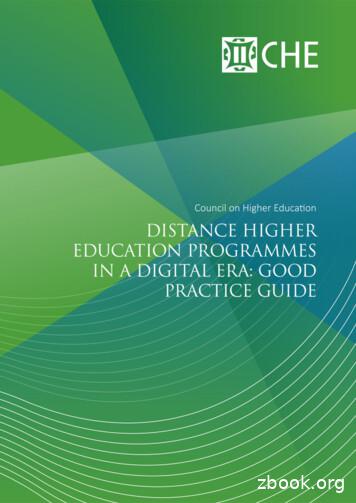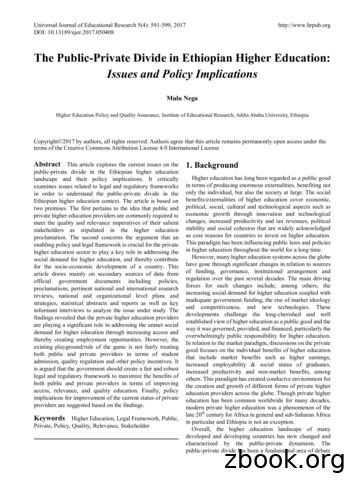Higher Education In Science And Engineering
Chapter 2Higher Education inScience and EngineeringHighlights.2-4Characteristics of the U.S. Higher Education System.2-4Undergraduate Education, Enrollment, and Degrees.2-4Graduate Education, Enrollment, and Degrees.2-5International S&E Higher Education.2-6Introduction.2-7Chapter Overview.2-7Chapter Organization.2-7The U.S. Higher Education System.2-7Institutions Providing S&E Education.2-7Trends in Higher Education Expenditures and Revenues.2-12Financing Higher Education.2-15Undergraduate Education, Enrollment, and Degrees in the United States.2-20Undergraduate Enrollment in the United States.2-20Undergraduate Degree Awards.2-24Graduate Education, Enrollment, and Degrees in the United States.2-27Graduate Enrollment by Field.2-27S&E Master’s Degrees.2-29S&E Doctoral Degrees.2-31International S&E Higher Education.2-37Higher Education Expenditures.2-37Educational Attainment.2-38First University Degrees in S&E Fields.2-38S&E First University Degrees by Sex.2-40Global Comparison of S&E Doctoral Degrees.2-41Global Student Mobility ces .2-48List of SidebarsCarnegie Classification of Academic Institutions.2-8Improving Measurement of Productivity in Higher Education.2-16Discipline-Based Education Research.2-23Master’s Completion and Attrition in S&E.2-30Professional Science Master’s Degrees.2-30Mapping Mobility in European Higher Education.2-40 2-1
2-2 Chapter 2. Higher Education in Science and EngineeringList of TablesTable 2-1. Degree-granting institutions, by control and level of institution: 2011–12.2-8Table 2-2. U.S. citizen and permanent resident S&E doctorate recipients whosebaccalaureate origin is a high Hispanic enrollment institution, by race andethnicity: 2007–11.2-9Table 2-3. U.S. citizen and permanent resident S&E doctorate recipients whosebaccalaureate origin is an HBCU, by race and ethnicity: 2007–11.2-9Table 2-4. U.S. citizen and permanent resident S&E doctorate recipients who reportedearning college credit from a community or 2-year college, by race and ethnicity:2007–11.2-10Table 2-5. Community college attendance among recent recipients of S&E bachelor’sand master’s degrees, by degree level and degree year: 1999–2010.2-10Table 2-6. Community college attendance among recent recipients of S&E degrees,by sex, race, ethnicity, and citizenship status: 2010.2-11Table 2-7. Title IV Institutions, by distance education status, control, and level ofinstitution: 2011–12.2-12Table 2-8. Net tuition and fees for full-time undergraduate students by institutionalcontrol: 2007–08 through 2012–13.2-16Table 2-9. Full-time S&E graduate students, by source and mechanism of primarysupport: 2011.2-17Table 2-10. Primary support mechanisms for S&E doctorate recipients, by 2010 Carnegieclassification of doctorate-granting institution: 2011.2-20Table 2-11. Foreign students enrolled in U.S. higher education institutions, by broadfield and academic level: 2008–12.2-24Table 2-12. Median number of years from entering graduate school to receipt of S&Edoctorate, by 2010 Carnegie classification of doctorate-granting institution: 1997–2011.2-33Table 2-13. Foreign recipients of U.S. S&E doctorates, by country/economy of origin:1991–2011.2-34Table 2-14. Asian recipients of U.S. S&E doctorates, by field and country/economyof origin: 1991–2011.2-35Table 2-15. European recipients of U.S. S&E doctorates, by field and region/countryof origin: 1991–2011.2-36Table 2-16. North American, South American, and Middle Eastern recipients of U.S.S&E doctorates, by field and region/country of origin: 1991–2011.2-37Table 2-17. Internationally mobile students in selected OECD countries and the UnitedStates: 2005 and 2010.2-43List of FiguresFigure 2-1. Community college attendance among recent recipients of S&E degrees,by field of most recent degree: 2003 and 2010.2-11Figure 2-2. Selected average revenues and expenditures at public very high researchuniversities: 1987–2010.2-13Figure 2-3. Average expenditures per FTE on research at public and private very highresearch universities: 1987–2010.2-13Figure 2-4. Average expenditures per FTE on instruction at public and private very highresearch universities: 1987–2010.2-14Figure 2-5. Selected average revenues and expenditures at public 4-year and otherpostsecondary institutions: 1987–2010.2-14Figure 2-6. Selected average revenues and expenditures at community colleges:1987–2010.2-15Figure 2-7. Full-time S&E graduate students, by field and mechanism of primary support:2011.2-18Figure 2-8. Full-time S&E graduate students with primary support from federalgovernment, by field: 2011.2-18Figure 2-9. Full-time S&E graduate students, by source of primary support: 1997–2011.2-19Figure 2-10. Freshmen intending S&E major, by race and ethnicity: 1997–2012.2-21
Science and Engineering Indicators 2014 2-3Figure 2-11. Engineering: Freshmen intentions and degrees, by sex.2-21Figure 2-12. Engineering: Freshmen intentions and degrees, by race and ethnicity.2-22Figure 2-13. Natural sciences: Freshmen intentions and degrees, by sex.2-22Figure 2-14. Natural sciences: Freshmen intentions and degrees, by race and ethnicity.2-22Figure 2-15. Foreign undergraduate student enrollment in U.S. universities, by top 10places of origin and field: November 2012.2-24Figure 2-16. U.S. engineering enrollment, by level: 1991–2011.2-25Figure 2-17. S&E bachelor’s degrees, by field: 2000–11.2-25Figure 2-18. Women’s share of S&E bachelor’s degrees, by field: 2000–11.2-26Figure 2-19. Share of S&E bachelor’s degrees among U.S. citizens and permanentresidents, by race and ethnicity: 2000–11.2-26Figure 2-20. First-time, full-time graduate enrollment in engineering and computersciences and unemployment rate of all workers: 2000–11.2-28Figure 2-21. S&E master’s degrees, by field: 2000–11.2-29Figure 2-22. S&E master’s degrees, by sex of recipient: 2000–11.2-31Figure 2-23. S&E master’s degrees, by race, ethnicity, and citizenship of recipient:2000–11.2-31Figure 2-24. S&E doctoral degrees earned in U.S. universities, by field: 2000–11.2-32Figure 2-25. S&E doctoral degrees earned by U.S. citizen and permanent residentunderrepresented minorities, by race and ethnicity: 2000–11.2-33Figure 2-26. S&E doctoral degrees, by sex, race, ethnicity, and citizenship: 2000–11.2-34Figure 2-27. U.S. S&E doctoral degree recipients, by selected Asian country/economyof origin: 1991–2011.2-35Figure 2-28. U.S. S&E doctoral degree recipients, by selected Western Europeancountry: 1991–2011.2-35Figure 2-29. U.S. S&E doctoral degree recipients from Europe, by region: 1991–2011.2-36Figure 2-30. U.S. S&E doctoral degree recipients from Canada, Mexico, and Brazil:1991–2011.2-36Figure 2-31. Attainment of tertiary-type A and advanced research programs, by countryand age group: 2010.2-38Figure 2-32. First university natural sciences and engineering degrees, by selected country:2000–10.2-39Figure 2-33. Natural sciences and engineering doctoral degrees, by selected country:2001–10.2-41Figure 2-34. S&E doctoral degrees earned by Chinese students at home universitiesand U.S. universities: 1994–2010.2-41Figure 2-35. Internationally mobile students enrolled in tertiary education, by selectedcountry: 2010.2-42
2-4 Chapter 2. Higher Education in Science and EngineeringHighlightsCharacteristics of the U.S. HigherEducation SystemDoctorate-granting institutions with very high researchactivity are the leading producers of S&E degrees atthe bachelor’s, master’s, and doctoral levels, but othertypes of institutions are also important in the educationof S&E graduates. In 2011, doctorate-granting institutions with very highresearch activity awarded 74% of doctoral degrees, 42%of master’s degrees, and 38% of bachelor’s degrees inS&E fields. Levels of debt of doctorate recipients vary by field. In S&Efields, high levels of graduate debt were most commonamong doctorate recipients in social sciences, psychology,and medical or other health sciences. At the time of doctoral degree conferral, nearly half of2011 S&E doctorate recipients had debt related to their undergraduate or graduate education.Undergraduate Education, Enrollment,and Degrees Baccalaureate colleges are the source of relatively fewS&E bachelor’s degrees but are a prominent source of future S&E doctorate recipients.Undergraduate enrollment in U.S. higher education rosefrom 12.5 million to 18.3 million in the 15 years endingin 2011. The largest increases coincided with the two economic downturns, 2000–02 and 2008–10. Master’s colleges and universities awarded close to 30% ofall S&E bachelor’s degrees and 25% of all S&E master’sdegrees in 2011. Associate’s colleges enroll the largest number of students,followed by master’s colleges and universities and doctorate-granting institutions with very high research activity. Nearly one in five U.S. citizens or permanent residents whoreceived a doctoral degree from 2007 to 2011 had earnedsome college credit from a community or 2-year college. Increased enrollment in higher education is projected tocome mainly from minority groups, particularly Hispanicsand Asians.Higher education spending and revenue patterns andtrends underwent substantial changes over the lasttwo decades.The number of S&E bachelor’s degrees has risen steadily over the past 15 years, reaching a new peak of overhalf a million in 2011. The proportion of S&E bachelor’s degrees has remained stable at about 32% duringthis period. Net student tuition more than doubled at public universities, whereas state and local appropriations fell by morethan 25%. Although tuition remained lower at public very high research universities than at their private counterparts, average revenue from student tuition increased more rapidly atpublic institutions. In public very high research universities, revenues fromfederal appropriations, grants, and contracts per full-timeequivalent (FTE) student nearly doubled between 1987and 2010, and research expenditures grew by 79% in thesame period. In private very high research universities,revenues from federal appropriations, grants, and contractsper FTE student grew by 61%, and research expendituresincreased by 89%. Since 2007, expanding enrollment at community colleges,coupled with reductions in state and local appropriations,contributed to an 8% reduction in instructional spendingper FTE student.Over the past decade in the United States, tuition andfees for colleges and universities have grown faster thanmedian household income. Undergraduate debt varies by type of institution and state.However, among recent graduates with S&E bachelor’sdegrees, the level of undergraduate debt does not varyby major. All S&E fields experienced increases in the numbers ofbachelor’s degrees awarded in 2011, including computersciences, which had declined sharply in the mid-2000s andhad remained flat through 2009. Women have earned about 57% of all bachelor’s degreesand half of all S&E bachelor’s degrees since the late 1990s.Men earn the majority of bachelor’s degrees in engineering, computer sciences, and physics. More women thanmen earn degrees in the biological, agricultural, and socialsciences and in psychology. Between 2000 and 2011, the proportion of S&E bachelor’sdegrees awarded to women remained flat. During this period, it declined in computer sciences, mathematics, physics, engineering, and economics.The racial and ethnic composition of those earning S&Ebachelor’s degrees is changing, reflecting both population changes and increases in college attendance bymembers of minority groups. For all racial and ethnic groups, the total number of bachelor’s degrees earned, the number of S&E bachelor’s degrees earned, and the number of bachelor’s degrees in mostS&E fields have increased since 2000.
Science and Engineering Indicators 2014The number of foreign undergraduate students in theUnited States increased substantially (18%) between fall2011 and fall 2012. Most of the increase in undergraduate foreign enrollmentwas in non-S&E fields. Within S&E fields, the largest increases were in engineering and the social sciences. China, South Korea, and Saudi Arabia were the top countries sending undergraduates to the United States.Graduate Education, Enrollment, and DegreesGraduate enrollment in S&E increased from about493,000 to more than 608,000 between 2000 and 2011. Graduate enrollment grew in most S&E fields, with particularly strong growth in engineering and in the biologicaland social sciences. Women continued to enroll at disproportionately low ratesin engineering (23%), computer sciences (25%), physicalsciences (33%), and economics (38%). In 2011, underrepresented minority students (blacks,Hispanics, and American Indians and Alaska Natives)made up 12% of students enrolled in graduate S&E programs, with Asians and Pacific Islanders representing 6%and whites 47%. Temp
Science and Engineering Indicators 2014 2-3 Figure 2-11. Engineering: Freshmen intentions and degrees, by sex . 2-21 Figure 2-12. Engineering: Freshmen intentions and degrees, by race and ethnicity . 2-22 Figure 2-13.
The Council on Higher Education (CHE) is an independent body established by the Higher Education Act, No. 101 of 1997. The CHE is the Quality Council for Higher Education. It advises the Minister of Higher Education and Training on all higher education issues and is responsible for quality assurance and promotion through the Higher Education .
Introduction to Science Section 2 The Branches of Science, continued The branches of science work together. -biological science: the science of living things botany, ecology -physical science: the science of matter and energy chemistry: the science of matter and its changes physics: the science of forces and energy -earth science: the science of the Earth, the
Science Color & Light Delta Science Module (DSM) 4 Science Mixtures & Solutions Kit Full Option Science System (FOSS) 5 Science Landforms Kit Full Option Science System (FOSS) 5 Science Variables Kit Full Option Science System (FOSS) 5 Science Environments Full Option Science System (FOSS) 5 Science Oceans Delta Science Module (DSM) 5
of our higher education clients. ABOUT EDUCAUSE EDUCAUSE (www.educause.edu) is a higher education technology association and the largest community of IT leaders and professionals committed to advancing higher education. Technol-ogy, IT roles and responsibilities, and higher education are dynamically changing. Formed in 1998,
public-private divide in higher education. This section presents a brief overview of the key concepts, debates, theoretical assumptions and factors that underlie discussions about the public-private divide in higher education. 3.1. The Concept of Public and Private Good in Higher Education . The public-private distinction in higher education has
6. Higher education policy updates 6.1. Policies of the Minister of Higher Education, Science, Research and Innovation On 31 July 2019, Dr Suvit Maesincee, Minister of Higher Education, Science, Research and Innovation, gave a policy speech to the management of the new ministry that summarised the key priorities of MHESI. The
NCC Education's Level 3 International Foundation Diploma for Higher Education Studies (L3IFDHES) is designed for speakers of English as a foreign language who are seeking to gain entry to Higher Education qualifications taught and assessed in English. NCC Education's Level 3 International Foundation Diploma for Higher Education Studies is:
higher education, science, and innovation; promote best practices in undergraduate and graduate education; and strengthen the contributions of research universities to society. University of Southern California Pullias Center for Higher Education The mission of the Pullias Center for Higher Educatio























